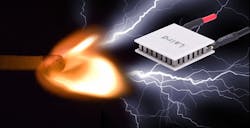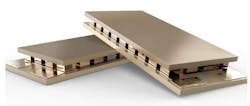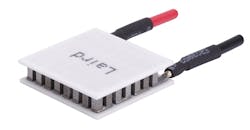Turning Heat into Electricity to Power Automation Devices
There are several scenarios in which supplying power to a device is difficult. For example, supplying power to small sensors attached to pipelines is hard to do, as power sources may be distant and require a large amount of industrial strength wiring. Then you have probes in remote locations such as deep sea or in space, which have no access to power sources whatsoever. Finally, slim portable electronic devices require long lasting power without constant recharging and minimal heat buildup.
In all these cases, thermoelectronics is the answer. Thermoelectric devices convert temperature differences into electricity without any moving parts. These devices are small and can turn wasted heat energy into electric energy savings.
How Thermoelectronics Work
Thermoelectric devices are comprised of thermoelectric modules. A thermoelectric module is an array of thermocouples connected electrically in series, but thermally in parallel. When a thermoelectric device is heated unevenly so that there is a resulting hot and a cold end, the temperature difference creates an electrical potential across the material known as the Seebeck effect. The resulting Seebeck voltage can be used to power electronic devices. (Image courtesy of CalTech)
When a thermoelectric device is heated unevenly, it creates what’s known as the Seebeck effect. This happens when one side of the device is hot and the other is cold. The Seebeck effect then produces a voltage, which can be harnessed to provide electricity to a device. Common materials used in today’s thermoelectric devices are bismuth telluride (Bi2Te3) or bismuth selenide (Bi2Se3). Lead telluride, magnesium group IV compounds, and slicides are other options. The main deciding factor is the zT value, determined by the element’s thermoelectric properties, Seebeck coefficient, electrical resistivity, and thermal conductivity.
Today’s thermoelectric devices are inefficient, mainly due to the limitations of the materials used. However, recent research from MIT reveals that restructuring the grain boundaries of the materials has the potential to create more efficient thermoelectric material.
Advances in Topological Materials
Phononics is one of the companies creating thermoelectric devices electronics cooling, refrigeration, and climate control scenarios. They have different sizes of devices, including a ruggedized version built to withstand harsh remote environments. (Image courtesy of Phononics)
The recent paper “Electron mean-free-path filtering in Dirac material for improved thermoelectric performance,” published in the Proceedings of the National Academy of Sciences, identifies the properties in topological materials to create higher efficiency thermoelectric materials. Te-Huan Liu, a post-doc in MIT’s Department of Mechanical Engineering—along with fellow MIT professors Jiawei Zhou, Mingda Li, Zhiwei Ding, Qichen Song, Bolin Liao, Liang Fu, and Gang Chen—wrote the paper.
Nanostructuring is the synthetic method of patterning features of materials at the nanoscale. Thermoelectric advantage in topological materials comes from a reduced thermal conductivity in their nanostructures. Through nanostructuring, one can dictate the proper thermal properties to create a more efficient thermoelectric material. However, scientists do not have a clear understanding of why this relationship exists.
Liu and his colleagues studied thermoelectric performance of tin telluride, which mimic properties in a topological material known as Dirac materials, in order to determine how and why the reduced thermal conductivity connects to enhancements in efficiency. The team simulated the path of electrons traveling through the material to determine the average distance an electron with a given energy would freely travel before being scattered.
Nanostructured materials are assembled via a patchwork of tiny crystals that create grain borders. When the electrons encounter these borders, they scatter. The longer the free path of the electron is, the stronger it will scatter. The team discovered that for tin telluride, electrons with lower energy possessed a longer mean free path than those with high energy.
The team then measured the thermoelectric performance and determined that the material’s ability to conduct electricity, or generate a flow of electrons under a temperature gradient, depends largely on the electron energy. Lower-energy electrons tend to have a negative impact on the generation of a voltage difference. However, the team reduced the average grain boundary to 10 nanometers and found that by bringing the boundaries closer together, there was an increase in higher energy electrons—hence a positive impact on voltage difference. High-energy electrons have a shorter mean free path and are less likely to scatter, which results in a larger voltage difference.
Laird is a leader in thermoelectric devices, and the ceramic plate series of thermoelectric modules is considered the standard in the industry. The rage of devices is available in numerous heat pumping capacities, geometric shapes, and input power ranges. Their devices use bismuth telluride for its semiconductor material and thermally conductive aluminum oxide ceramics. They are designed for high current and large heat pumping applications. (Image courtesy of Laird)
Lie and his team determined that, based on their simulations, one can achieve similar performance by synthesizing other topological materials to have smaller grain sizes using a nanostructure technique. For example, the team found that by decreasing tin telluride’s average grain size to about 10 nanometers, it was able to generate three times the amount of electricity it would typically produce with larger grain boundaries.
If thermoelectric devices could increase in their power output, they could be applied to larger-scale industrial applications. The heat generated by oil piping, hydraulic equipment, pneumatic devices, factory assembly, and other manufacturing techniques could be used to power sensors and other thermoelectric devices. In the current world of IoT connectivity and intelligent devices, having remotely self-powered sensors would be immensely beneficial.




